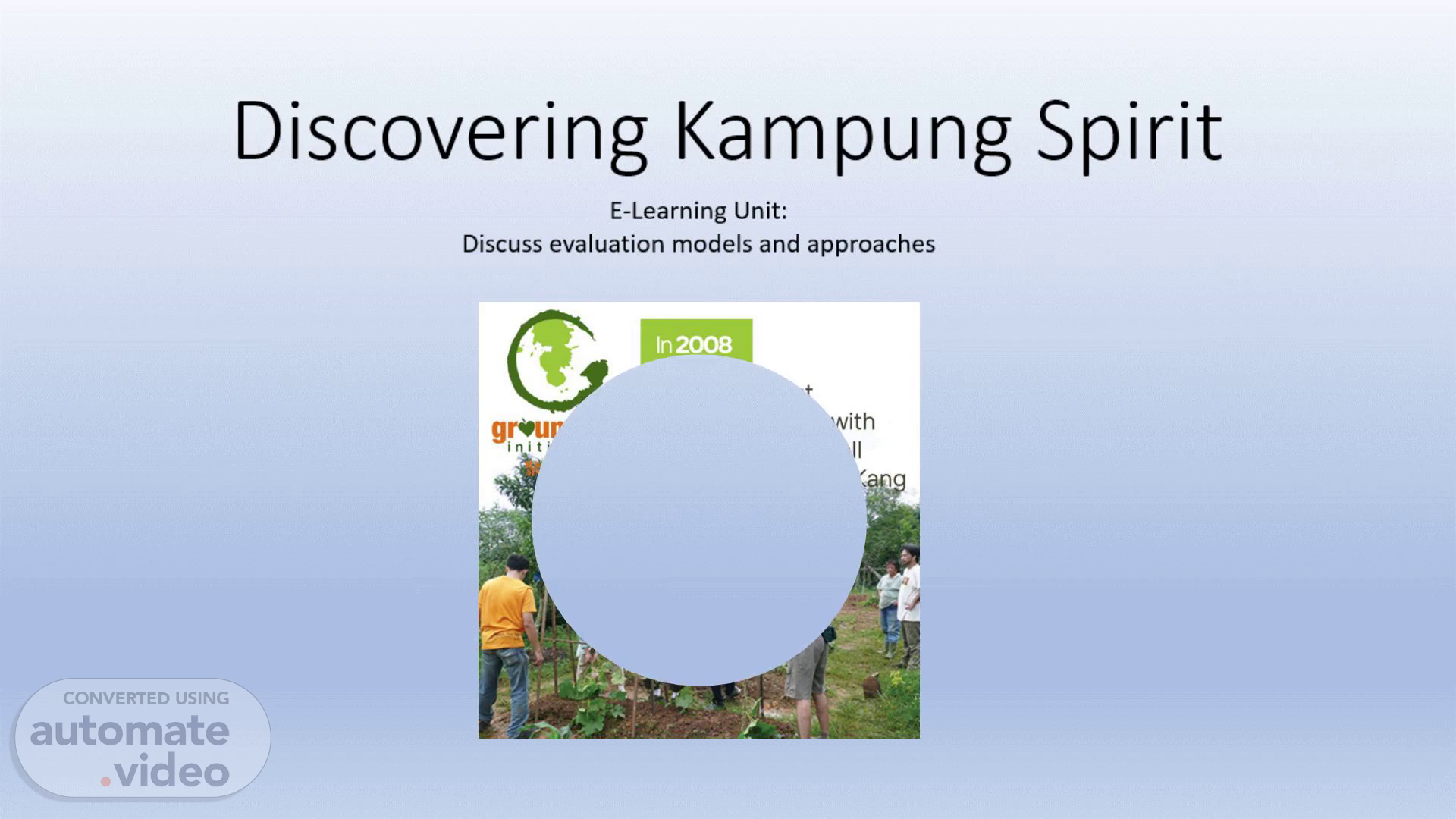
Discovering Kampung Spirit
Scene 1 (0s)
[Audio] You would have already known by now that the very first programme Ground Up Initiative G.U.I. ran was the Balik Kampung programme in the year 2008. It started with 10 people in a small corner of Lim Chu Kang. How do we know the quality of our programme? This is the E-Learning Unit of Discovering Kampung Spirit Module. Let us discuss on the evaluation models and approaches to help us with this..
Scene 2 (30s)
[Audio] You get to decide on which model you want to learn. The Pre-Training Guide has some information that you may want to know about the model prior to going into details..
Scene 3 (45s)
[Audio] The Kirkpatrick's Model of Training Evaluation is developed by Mr Donald Kirkpatrick. The model consists of four levels: Reaction, Learning, Behavior, and Results. It helps to evaluate the training effectiveness at different levels, from immediate reactions to long-term organizational impact..
Scene 4 (1m 10s)
[Audio] The Return on Investment (ROI) model by Jack Phillips is an extension to Kirkpatrick's model. It includes financial analysis. It measures the monetary benefits of training that are compared to the costs and the linking of training outcomes to organizational financial gains..
Scene 5 (1m 30s)
[Audio] The Brinkerhoff's Success Case Method focuses on identifying both successful and unsuccessful outcomes to understand the factors contributing to success or failure. It involves in-depth interviews and analysis of key success stories and challenges..
Scene 6 (1m 48s)
[Audio] The CIPP model evaluates programmes across four dimensions: Context, Input, Process, and Product. It assesses the needs, resources, implementation, and outcomes of the training programmes..
Scene 7 (2m 7s)
[Audio] For the Kirkpatrick Model, the first level of evaluation is Reaction. It gathers feedback from participants about their satisfaction and perception of the training programme. The second level is Learning. It assess the knowledge and skills acquired by participants during the training. The third level is Behavior. It evaluates if participants are applying what they learned in their day-to-day activities. And the fourth level is Results. It measure the impact of the training on organizational goals and outcomes..
Scene 8 (2m 47s)
[Audio] The Return on Investment (ROI) model by Jack Phillips is an extension to Kirkpatrick's model. The added fifth level evaluates the degree to which the training has on the financial returns for the business..
Scene 9 (3m 6s)
[Audio] Finding out quickly what's working and what's not. The Success Case method by Robert Brinkerhoff involves identifying the most and least successful cases in a programme and examining them in detail. First, we identify a programme and it's intended outcomes or impact for evaluation. Second, we create an impact model or rubric that defines what success should look like for the programme. Third, through a survey or other method, identify the most and least success cases. Fourth, we conduct interviews with the most and least cases and document why they performed well or not. Lastly, we document and share the stories to report impact, applaud successes and share lessons..
Scene 10 (3m 56s)
[Audio] CIPP Context Input Process Product Evaluation Model is a comprehensive evaluation model that assesses various aspects of a programme. The Context evaluation understands the needs and objectives of the training programme. The Input evaluation assesses the resources, facilities, and materials available for the programme. The Process evaluation evaluates the actual delivery and implementation of the training. And the Product evaluation measures the outcomes and impact of the training on participants and the organization..
Scene 11 (4m 36s)
[Audio] We have come to the end of the lesson on evaluation models. We hope that you have enjoyed this self-pace learning. See you at Kampung..